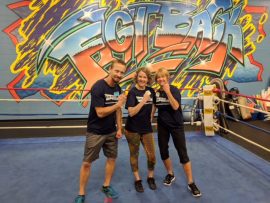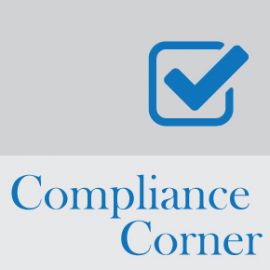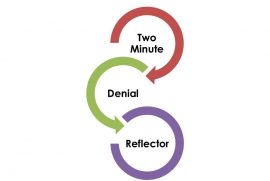
Poster Portfolio


The Emerald Market has been focusing on building a partnership with the Heartland PD Foundation in an effort to enhance and grow our facility programs. Initially we met with the Foundation’s Community Program Manager, Kim Nitz, to inquire if they had any unmet needs and to discuss how we could possibly meet those needs. Her first response was sponsorship of their fundraising and awareness events like The Moving Day PD Walk and secondly providing meals after their weekly exercise class to both participants and their caregivers.
As a Market, we became a Bronze Sponsor — as shared in a previous FlagPOST. Beginning in May, the Healthcare Resort of Kansas City, Riverbend PARC, the Healthcare Resort of Leawood, and the Healthcare Resort of Olathe started providing lunch for 25 participants and their caregivers on a monthly basis. The focus was more on building relationships rather than heavily marketing our programs/facilities per the request of the Foundation.
We had great dialog at the initial meet-and-greet lunch and were able to provide educational pieces based on their feedback at the subsequent lunches. We discussed safe transfer training techniques, how to cope with “freezing” during transfers, car transfers, balance deficits and balance exercises. The initial four months were such a success that the Foundation has invited us to continue to hold lunch and learns until the end of the year. I strongly believe our partnership has been so successful because the participants see and feel our sincere compassion for the PD community.
As a Market, our goal is to establish and offer a PD Support Group by the first of the year in the northern part of the city at the Healthcare Resort of Kansas City and the southern part of the city at the Healthcare Resort of Olathe. We are diligently working to increase our relationships with Movement Disorder Physicians and vendors to have as possible guest speakers at our support groups.
I look forward to sharing the next chapter in our PD program development successes after the first of the year.
By Madeana Galler, Therapy Resource – Emerald Market, Kansas

I wanted to officially introduce our newest Kansas Rock Steady Boxing Coaches (see photos)! They have had their new titles for one week and had 5 calls for patients ready to start the program. We are super excited for what’s to come! Pictured: Jill Casey Weyer – COTA, Valerie Briggs – OT, Nik Kalinichenko – PTA
Rock Steady Boxing (RSB), a 501(c)3 nonprofit organization founded in 2006, gives people with Parkinson’s disease (PD) hope by improving their quality of life through a non-contact, boxing-inspired fitness curriculum. RSB’s mission is to empower people to “fight back” against Parkinson’s disease and enriches both individuals and the community by improving the wellness of older adults.
RSB is the only organization in the world well-positioned with an effective, replicable model to address the quality of life needs of men and women dealing with Parkinson’s disease today. Bring RSB and hope to your community by becoming an affiliate of Rock Steady Boxing.
As an affiliate of Rock Steady Boxing you will have the benefit of brand marketing, training support, website presence, startup materials and online certification training. Read More…RSB Benefits of Affiliation
By Jordynn Knipp, DOR, The Healthcare Resort of Olathe, Olathe, KS
C

By Brian del Poso, Associate Compliance Partner
With just about three-fourths of the year completed, it’s a good time to provide an update on where we stand compliance-wise and what’s on the horizon for the rest of the year. Therapy documentation and technical accuracy has come a long way, so kudos to all of you. There are still a few areas, however, that we can pay closer attention to. These items will sound familiar as they have been identified in years past and have improved, but we definitely still need to consistently get better at:
Again, there has been improvement in these areas, but there’s definitely a high ceiling for growth. I encourage you all to seek further education and training in these documentation areas. The easy way out would be to look at some of these things and just say, “Well, we just won’t do co-tx anymore,” or “We don’t use physical agent modalities often, so…,” but the easy way out isn’t who we are. Let’s invest in each other and in the spirit of our core value of PASSION FOR LEARNING, and utilize the therapy resources, POSTettes, and compliance partners we have at our disposal to move ourselves forward.
Part A MSCAs were on a bit of a hiatus as the IRO summer season began, but they are starting up again as we speak. With that said, here’s a YTD look at some of our top-performing facilities from the MSCAs. Congrats and keep it up!
| 2018 MSCA Overall Scores | 2018 MSCA Therapy Dept. Scores | |||
| Facility | Top 5 | Facility | Top 5 | |
| Timberwood (Keystone) | 99.27% | The Grove (Signum) | 100.00% | |
| Panorama Gardens (Signum) | 99.11% | Golden Acres (Keystone) | 99.53% | |
| Brookside (Signum) | 99.04% | Northbrook (Signum) | 99.53% | |
| Claremont (Signum) | 98.45% | Atlantic (Signum) | 99.43% | |
| Sea Cliff (Signum) | 98.39% | Brookside (Signum) | 99.40% | |
If you’d like to know where you rank within your company, please reach out to your local compliance partner, and we will get that information out to you.
Coming up in Q4, we’ll be wrapping up any leftover MSCAs, and similar to recent years, we will also be starting up Part B MSCAs. As a reminder, not all facilities will receive a Part B audit this year. Facilities chosen for Part B audits will be dependent on the size of your Part B program. Essentially, if your YTD Part B revenue hits a certain threshold, you’ll be in the pool for a Part B audit. We’re currently working on the threshold to see how much revenue makes sense for a cutoff point, so more to come from your local compliance partners.
Lastly, I’m sure you all have heard or seen the emails about our Independent Review Organization (IRO) audits. We’re not out of the woods yet and still have the remote portion coming up, but we wanted to give a shoutout to this year’s on-site facilities (Legend Oaks Kyle, Golden Acres, Rehab Center of Des Moines, Grand Oak, Redmond, HCR CO Springs, Heritage Park, Brookfield) for doing such an awesome job in our very last CIA and IRO year!

The land swelled below the wing of the plane in gentle shades of green and brown, revealing ample squares defining crops, and the perimeter of a small community where various creeks meander through town before combining to become the Walla Walla River, which drains into the Columbia River about 30 miles west of town. Park Manor Rehabilitation Center is nestled in the farmlands of eastern Washington.
One sweltering hot morning, Sonya, DOR and Zewdi, DON and the IDT team calmly evacuated over two dozen residents to the dining area to preempt any issues with dehydration in a seamless flow of activity. The team identified that the temperature in one wing was too high for the medical well-being of their residents and made the decision as a group during the morning Standup Meeting. Within minutes, people self-organized to provide a pleasant alternative to the overheated area of the building for the patients in the affected wing. Soon the residents were seated comfortably in the dining room, offered beverages and provided with activities to engage them for the morning. Being a part of this particular morning left me with a powerful experience of Ownership, a core value for us at Ensign.
In practice, ownership takes many forms, reflecting the composition of the people who form those teams. As I reflected on why this team seemed so special, I realized that while their location set them apart in very practical terms, the quality of their interactions were definitively harmonious, often uplifting and consistently grounded in sound clinical and operational practice. These lovely people had figured out how to keep the fire lit and love one another through the usual travails of long-term care. I was struck by the balance of utter focus and levity during the morning meetings. This created the critical element of mutual understanding for each patient’s current medical and functional status for a better quality of patient care.
I was particularly struck by the level of individualized attention to ensure that each patient was situated well and individual or family needs were considered. The objective aspects of patient care were navigated skillfully while the personal needs of each patient were also thoroughly respected.
Over the course of a few days, there were many opportunities to get to know this team, and I found myself pondering how to describe what I was experiencing. There were eight factors that seemed to play a part in this team’s capacity to work so well together.
This generosity was the spirit of ownership. It was so seamlessly implicit in the functional performance of this team that I almost missed it. The word “ownership” in our secular culture has come to mean possession, yet here, the opposite is true. When we consciously choose to open up and own more, to bring awareness and act as if our collective results are actually our own, new possibilities open up. New perspective. New hope.
By Willow Dea, Leadership Development
 By Lori O’Hara, MA, CCC-SLP – Therapy Resource, ADR/Appeals/Clinical Review
By Lori O’Hara, MA, CCC-SLP – Therapy Resource, ADR/Appeals/Clinical Review
CMS doesn’t define a lot of requirements for what needs to be in a daily note, understanding that it’s what happens during the session that drives the content. But one of the places where they do define a requirement is on the day of the evaluation. Because evaluation minutes don’t count towards the calculation of a RUG score, but treatment minutes do count, they want to be able to see easily that those things were different when they occur on the same day. That means a narrative entry is always required when treatment occurs on the day of the evaluation.
What needs to be in the note? Content that describes how activity billed to the treatment codes was clearly not activity that should have been billed to the evaluation code. So the content in the therapy CPT boxes should describe skilled activity associated with the specific treatment code being billed.
Content that is providing detail on the evaluation findings, interpreting scores or risks associated with testing performance with the patient or family, or describing goal setting is evaluation related. So this cannot be billed towards a therapy code and should not be documented in therapy CPT boxes.
Education about the patient’s conditions or limitations, trialing devices or attempting environmental adaptations, and specific therapeutic interventions are treatment related and should be billed to and recorded as their corresponding CPT codes. Content should be detailed enough that it’s evident to anyone reading that those activities were clearly distinct from the evaluation activity.
Reviewers are starting to look for this – managed care organizations too! So, protect your minutes on your evaluation day content that is just as amazing as the services you provide.